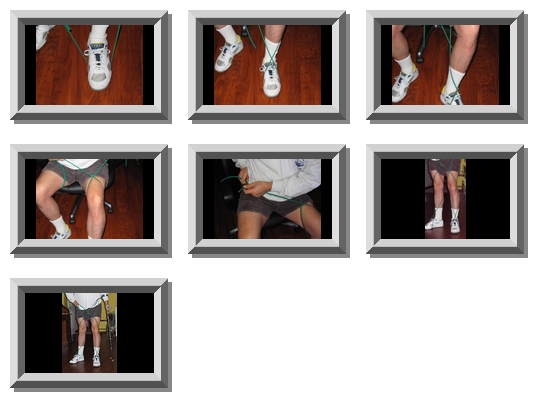- Introduction
- Cords
- How to Tie
- Videos
- Previous Gate Patterns
- Therapeutic Horse riding - 7/7/2006
Video taken at Freedom Hills.
Introduction
I was diagnosed with Transverse Myelitis in the summer of 2001. I have been pursuing various physical therapy regimens in an attempt to retrain my nervous system.The idea of using Theracord in the manner described below came from experience that my therapist, Chris, gained when he worked at the Kessler Institute.
I was interested in trying to walk on the treadmill without braces. I was hoping to strengthen various muscles in the ankle, and since the left MAFO has a plantarflexor stop, I wanted to practice pushing off and flexing the ankle. However, tone and weakness would limit my gait.
When I asked Chris about this, and I suggested tying a Theraband from my calf to my foot, giving me the needed lift, he recalled the technique presented here. The method of tying the Theracords presented here gives me a feeling much closer to a natural gait pattern than almost anything I have felt.
We started using the medium weight cord - green. I recently
tried a blue cord, but the pressure of the cord about the hips
bordered on painful.
I have a 30" inseam, 38" waist; the bands are 60". I tie them
so there is a few inches left at the ends. Enough to make it
easy to tie, but not an excessive amount left over.
The cords have lasted surprisingly long - at least 3 months.
I use them 3 times a week for 20 minutes each session on a
treadmill. I walk around with them occasionally in the clinic.
As used here, they are not suitable for walking on pavement or
other abrasive surfaces. Linoleum is tricky because the cord
can really stick.
The cords do not ever move around on the bottom of my sneaker.
I don't have unusual sneakers. Actually, the tread is fairly worn.
At some point, we would like to develop a more adjustable system
with an attachment to the shoe allowing for more general wear.
However, long term wear is not going to be very comfortable.
Twenty minutes on a treadmill plus approximately 20 minutes of
other exercises is fine. But, I can not see wearing them all day.
I feel the training I get from the cords is somewhat like having
a therapist move your leg when doing suspended treadmill training
(I have had this done before). I believe that if the suspension
is available, but there are not enough therapists available to
move the legs and hips, the Theracords might provide enough leg
assist allowing the therapist to concentrate on either the hips
or perhaps just one leg in particular.
The easiest way to see how is to watch the
movie. The movie is fairly large
at 25MB. If you have a dialup connection, or if your computer
has problems playing back the movie, try saving it to disk and
playing it outside of your browser. On most computers, you
can Shift-Click the movie link and when prompted, save the file
to disk. The movie file is a standard mpeg-1 video.
The following photos will also describe how to tie the bands.
Click on an image to see a larger version.
Nothing is perfect. If the tension is not fairly even on each
side, the leg can be pulled sideways. If you are prone to
barely clearing or actually stubbing your foot, the cord will
make it that much easier. However, if your therapist
feels the cords might help, it is certainly easy enough to
make the attempt
The following videos show me walking with the cords on:
Additionally, the evaluation videos show
me walking on a treadmill using the bands.
Cords
The cord is a standard Theracord green cord.
How to Tie the Theracords
When starting, make the loop around the foot near the middle
the arch. If you make it too near the ball of the foot, the cord
can slip off and hit you in the face. After everything is tied,
move the cord towards the ball of the foot.

Walking with the Cords On
The cords help lift the leg to a certain extent, but they also
provide a stimulus that helps the body know when the leg
should be moved.